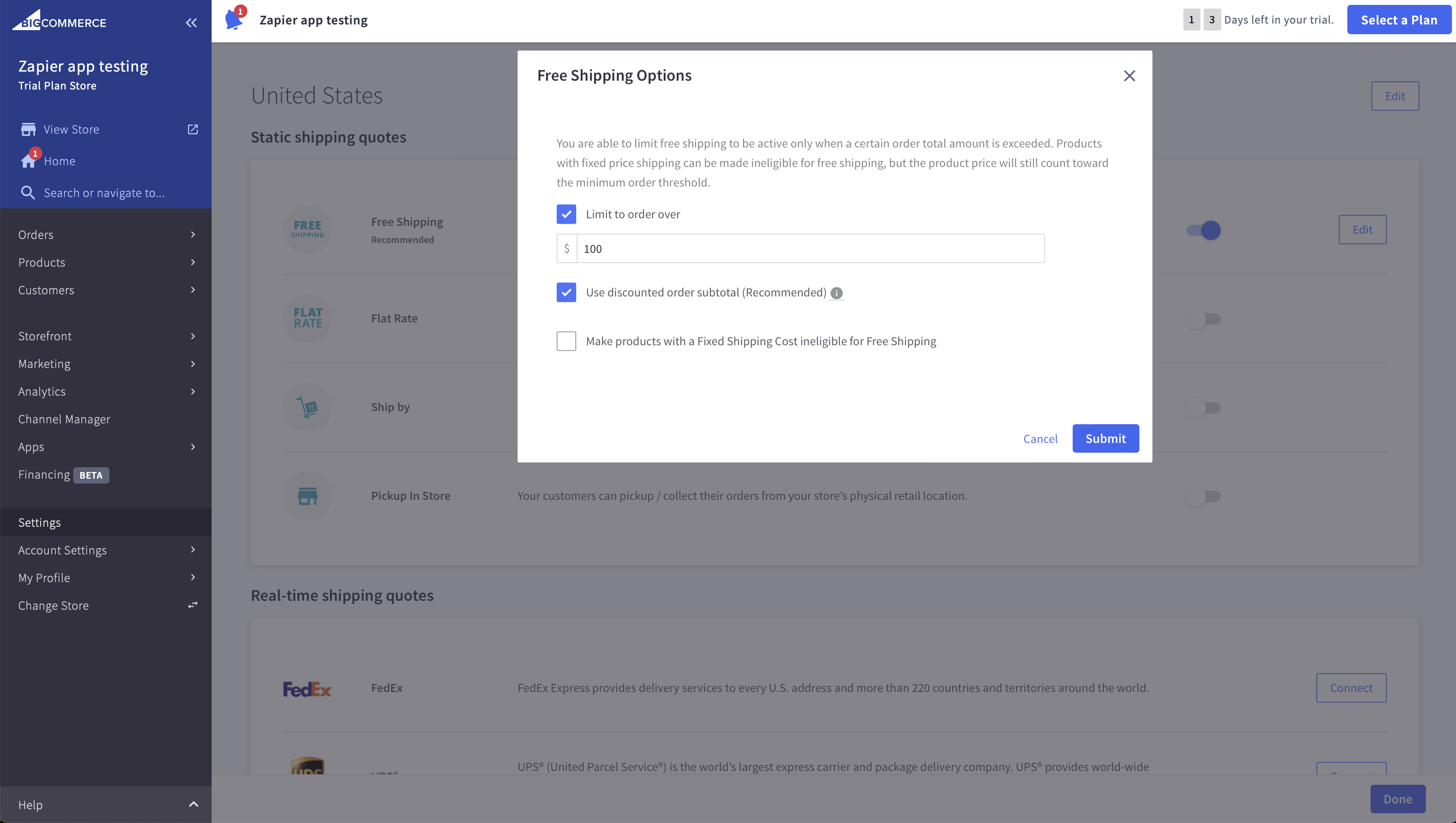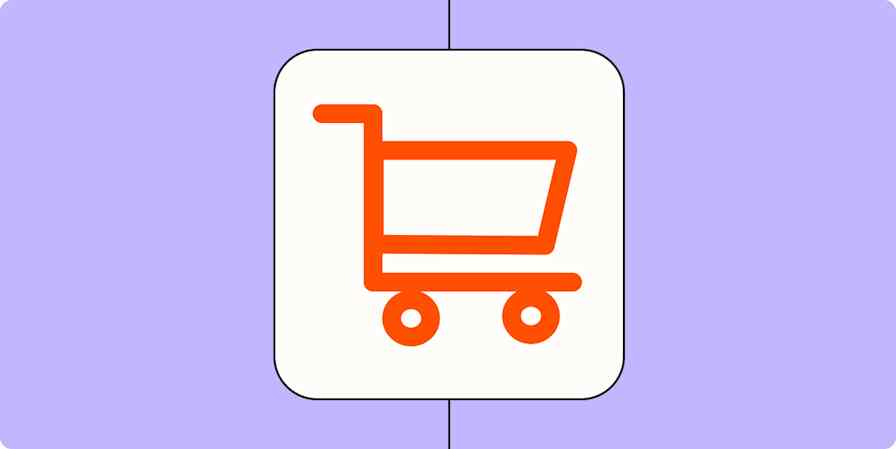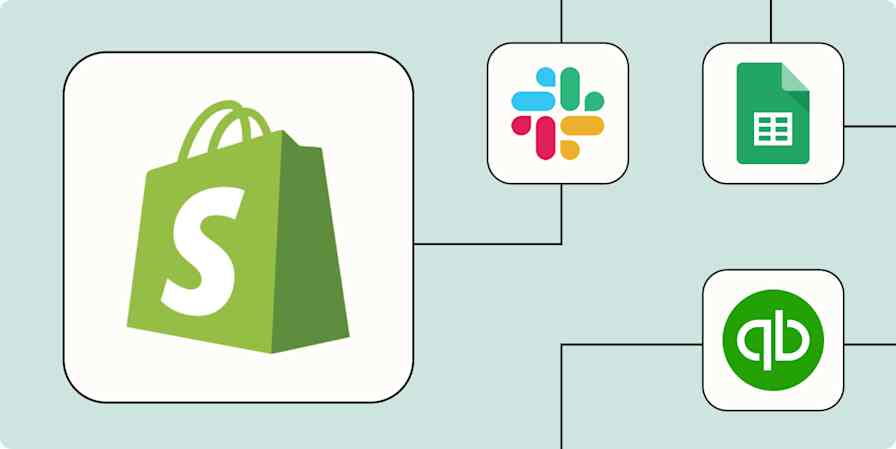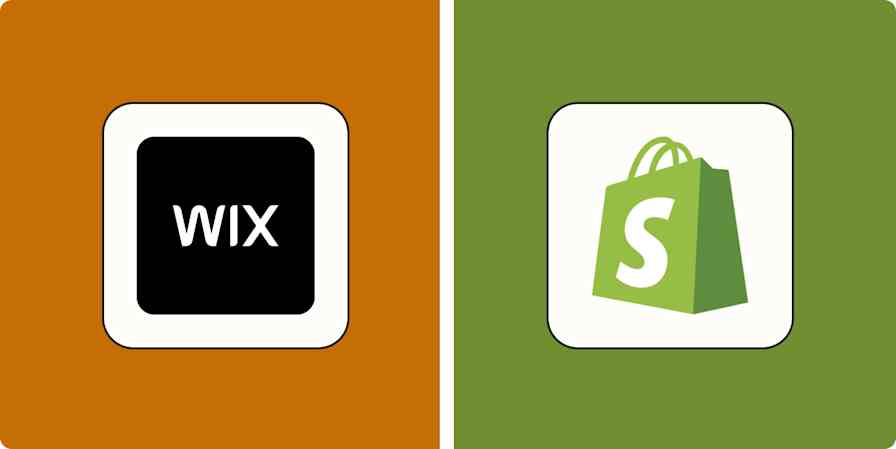We independently review every app we recommend in our best apps lists. When you click some of the links on this page, we may earn a commission. Learn more.
Online sales continue to grow. Last year, more than a fifth of all retail sales happened online, and eCommerce is a multi-trillion dollar market. So, if you have a small business, you should probably have a web store. The good news is that with the right tools, it's easy for any small business to quickly start selling online.
With one of the best eCommerce website builders, you can list your products, take payments, and handle shipping, all without leaving the comfort of your store (or home office).
In researching this list, I looked at more than 50 different options for building eCommerce websites. There are solutions for every kind of business, from indie creatives to multinational corporations, but for this list, I focused on platforms that best fit the needs of small and medium businesses, especially those newly exploring selling online or selling physical products. This isn't to say my picks won't work for other kinds of businesses, but if you're selling a couple of dollars a month worth of Lightroom presets or $50 million worth of potatoes, you might want to look elsewhere. (Though you can scroll to the end to get some options for smaller creatives or makers as well as large enterprise companies.)
Here are the six best eCommerce platforms.
The 6 best eCommerce website builders
Shopify for getting up and running quickly
Square for selling in-person and online
Ecwid by Lightspeed for starting with a free plan—then growing
BigCommerce for large-volume sellers
WooCommerce for adding a shopping cart to a WordPress site
Wix for building a complete site
What makes the best eCommerce website builder?
How we evaluate and test apps
Our best apps roundups are written by humans who've spent much of their careers using, testing, and writing about software. Unless explicitly stated, we spend dozens of hours researching and testing apps, using each app as it's intended to be used and evaluating it against the criteria we set for the category. We're never paid for placement in our articles from any app or for links to any site—we value the trust readers put in us to offer authentic evaluations of the categories and apps we review. For more details on our process, read the full rundown of how we select apps to feature on the Zapier blog.
For typical small and medium businesses looking to sell physical products online (or at least a mix of physical and digital products), I identified five key features that every platform had to offer. There are other good platforms out there, but if they don't offer a feature on the list, they didn't make the cut, as they're either too niche or too basic for most businesses.
A mildly tech-competent person had to be able to build a good-looking, responsive, modern online store with the tools and themes offered—without needing a computer science or graphic design degree. If you can set up an email account on your iPhone, you should be able to use these picks. Also, the website builders had to allow you to make everything fit with your existing brand materials. This one criterion actually eliminated quite a few platforms from consideration for being either too limited with boring, super similar, or outdated themes, or requiring too much technical know-how to make the most of them.
You have to be able to sell whatever you want, wherever you want, however you want. This meant it had to be able to handle both digital and physical products and offer some way to manage sales taxes and international shipping. This last point is particularly important for small businesses: if you have physical premises or plan to sell internationally, you may be liable for collecting and filing various kinds of taxes.
I only considered full-service eCommerce platforms. You need to be able to sell your product through a consumer-facing website, but also manage orders, ship goods, track inventory, and otherwise deal with the back-end running and admin of your eCommerce store without using some other service or (please no) a giant spreadsheet.
Whatever platform you choose, it has to play nice with any other apps and services you rely on for your business. For this reason, I required the apps on this list to have a range of integrations, either through a plug-in and extension marketplace, built-in features, or connecting to Zapier. You should be able to send your orders straight to your accounting software.
All of this had to be available for a clear and affordable monthly price. Opaque fees were a big no, and while done-for-you solutions are wonderful, they cost thousands of dollars per month—far more than any SMB needs (or has) to spend on setting up an eCommerce site.
To test all the different online store builders, I signed up for an account and…set up an online store! I went through the signup process, built out a simple site, added a few products, and generally went through all the steps that someone starting out on the platform would go through. Really, the only thing I didn't do was start selling products (much to my accountant's disappointment).
This was enough to get a feel for most eCommerce website builders and allowed me to make sure they met my core criteria. From there, I was able to compare and contrast the various different options to find the best eCommerce builders for most people. I've been updating this list for the past few years, so at this point, I'm very familiar with all the major platforms and confident that these picks are the best options for most small businesses.
How to choose the right eCommerce website building platform for your online store
If you're new to eCommerce platforms, it can be a bit overwhelming. Here are the primary things you should focus on when making your pick:
Budget. Start small, and scale as you need. While it's tough to find a robust free option, you can get a feel for a product on one of its lower tiers before committing to something that will break the bank. Just make sure that the higher plans will still meet your needs in the future.
Features. Of course, your budget will affect the features. All the eCommerce website builders on this list offer the basic features, but if there's one thing that's a dealbreaker for you (e.g., the ability to also sell in person), start there and work backward.
Your familiarity with website builders. Some apps are just more beginner-friendly. Your time is valuable, so if you're not super technical, be sure you feel ok navigating the interface.
Support. When you run into issues, are you comfortable troubleshooting on your own? If not, you'll want to prioritize support features.
Analytics. Robust analytics are important as you grow, so be sure the platform you choose is reporting on your metrics in a way you feel confident analyzing and acting on.
Whatever option you select, remember, the number one priority is actually selling your product. Don't get too caught up tweaking the minor details of your online store when you should be focused on more important aspects of your business.
How much does an eCommerce website cost?: eCommerce software fees
While we're talking about pricing, it can get a little complicated with eCommerce platforms as they charge a little differently from other services. There are three kinds of fees you may have to pay for an eCommerce website builder:
Monthly fee. This is anything from free to a few hundred dollars and goes straight to the platform. For most of the eCommerce services on this list, expect to pay around $30 to $40 per month for a basic plan.
Payment gateway fees. These are the fees you pay when you process a credit card charge. The normal fee is around 2.9% plus an additional $0.30, although this goes down with volume and higher upfront payments. Some platforms, like Wix and Shopify, operate their own payment gateways that you can choose to use, while others rely on Stripe, PayPal, and similar services.
Transaction fees. These are another percentage-based fee that's on top of any gateway fees. A lot of eCommerce sites bill themselves as having 0% transaction fees, but this merely means there's no extra charge. Other services charge a 1% or 2% transaction fee if you don't use their gateway.
Let's give this a quick example using Shopify's current pricing. A Basic plan costs $39/month. On top of that, you pay 2.9% + $0.30 for each transaction. There's also a 2% transaction fee if you want to use a different payment gateway.
This means that if you were to sell 10 T-shirts at $50, you would pay Shopify $39 for your monthly plan, and $1.75 for each T-shirt sold. That's a total of $56.50. Of course, if you had a month where you didn't sell any T-shirts, you'd only pay $39, or if you had a great month where you sold 50, you'd pay $126.50.
Also, if you sold 10 T-shirts but decided to use Stripe's payment gateway instead, you'd pay Shopify $49 ($39 plus $1 for each T-shirt sold) and Stripe $17.50 (2.9% + $0.30 for each T-shirt), for a total of $66.50.
As you can see, your monthly costs will vary based on what options you choose and how you run your business. I'd recommend doing a few back-of-the-envelope calculations when you're selecting your plan and payment gateway, just to see what will work out best for you. I've avoided selecting online store websites with unreasonably high fees and transaction charges, or ridiculous volume expectations, but run some numbers to be sure.
With that, here are the best eCommerce websites.
The best eCommerce website builders at a glance
Best for | Pricing | Transaction fees | Website | |
|---|---|---|---|---|
Getting up and running quickly | From $39/month for unlimited products | 2.9% + $0.30 per transaction with the built-in payment gateway | ||
Selling in-person and online | Free for unlimited products and a Square branded site; from $29/month to remove branding | 2.9% + $0.30 per transaction | ||
Starting with a free plan—then growing | Free for standard features; from $25/month for professional features | Depends on payment gateway | ||
Large-volume sellers | From $39/month for unlimited products | Depends on payment gateway | ||
Adding a shopping cart to an existing WordPress site | Free for standard features on a self-hosted WordPress site | Depends on payment gateway | ||
Creating an online store and business website | From $43/month | 2.9% + $0.30 per transaction with the built-in payment gateway |
Best eCommerce website building platform for getting up and running quickly
Shopify (Web, iOS, Android)

Shopify pros:
Easy to set up and offers all the tools you need
Popular and effective, so support and resources are best in class
Shopify cons:
Can be expensive, especially if you add lots of extra apps
Shopify has been around for more than 18 years—with millions of stores built using the platform—and it's hard to find a better option for most small businesses looking to get an online store up and running quickly.
Sign up for a credit card-free three-day trial, and within a few minutes, you can have a first build of your store ready to go. The onboarding wizard walks you through adding your products, customizing the look of your store, connecting your own domain, and getting set up to take those all-important payments.
Even if you've never built a website before, you're unlikely to get lost in Shopify's intuitive web app. Everything is clearly labeled, buttons do what you think they should, and the help docs and setup guide are comprehensive. Things like designing your store, adding a product, creating discounts, configuring payment options, and checking your sales numbers are all simple and largely self-explanatory.
While Shopify ticks most boxes right out of the gate, its extensibility and app store are what really make it such a powerful option. Take the theme situation: Shopify has 13 free themes and 218 paid themes starting from $100. But because Shopify is so popular, you can also find more than 2,300 themes available on ThemeForest or get a professional designer who's already experienced with the platform to make you a custom one.
It's the same with almost any feature you could want. If it's not built into Shopify, you can find an extension, plug-in, or service that does it in the Shopify app store. (There's even a point-of-sale solution if you have a physical store.) Just go to apps.shopify.com, and find the app you need. Be warned, though: adding lots of apps can quickly increase your monthly fees.
Of course, like many apps, Shopify is adding deeply integrated AI features it calls Magic. Some features, like generating text for product descriptions or your site, are available now, while others, like an AI assistant called Sidekick, are still in early access. They don't massively change the overall experience of using Shopify, though Sidekick's abilities to analyze your sales data and make suggestions seem super interesting.
It should be no surprise that Shopify integrates with Zapier, allowing you to orchestrate workflows that connect your storefront with the rest of your business operations. For example, when a new order comes in, Zapier can update your inventory, use AI to create a tailored invoice in your accounting tool, and notify your fulfillment team in Slack. This way, sales, finance, and operations all stay aligned without manual effort. Discover more ways to automate Shopify.
Shopify price: Free for 3 days; from $39/month and 2.9% + $0.30 per transaction for Basic Shopify plan with unlimited products
Best eCommerce website building platform for selling in-person and online
Square (Web, iOS, Android)

Square pros:
Integrates with Square's point-of-sale system
Weebly's site-builder still holds up nicely
Square cons:
Limited themes and customization options compared to some other tools
If you run a small business and want the option to sell in-person, like at a farmer's market or craft fair, as well as through your online store, Square—better known for its point-of-sale terminals—is a great choice. It's really designed for offline businesses and retailers that are looking to make the jump online, rather than internet-first sellers. Things like online and offline orders are all organized under a single dashboard, so there's no jumping between apps, trying to track down customer details using random spreadsheets, or having to enter things manually after the fact.
Square bought the website builder app Weebly in 2018, so when you set up your store, that's what's running under the hood. If you occasionally see a URL direct to weebly.com, it's nothing to worry about.
Square has some of the best onboarding around. When you sign up, you have to fill in a detailed questionnaire about your business and its needs, and it will walk you through the process of configuring everything to meet them. However you want to sell stuff, Square makes it easy.
In terms of storefront customization, Square is a little more limited than some of the other options. Free users have to make their own design using the (still solid) site builder, while Plus subscribers can use customizable themes. Alternatively, you can hire a designer (starting at $999) to configure your site for you.
Where Square really stands out is in how it combines your offline and online business. Your web store is just another sales location, so everything is treated equally. You can even sync inventory levels, so if you sell your last widget at a farmer's market, someone won't be able to order it online later that day.
If you have a Square credit card reader (available for free) or other Square point-of-sale tool, you can swipe your customers' cards for a 2.6% + $0.10 fee from Square, and their details will automatically upload to your account. Online, Square's charges are similar. On the free plan and Plus plans, you're charged 2.9% + $0.30 per transaction.
Square also integrates with Zapier, letting you orchestrate eCommerce workflows at scale. For example, when a new order is created, Zapier can update your inventory in a spreadsheet, create a fulfillment task in your project management tool, and use AI to draft a personalized confirmation email. Here are even more ways to automate Square.
Square price: Free with 2.9% + $0.30 per transaction for unlimited products and a Square branded site; from $29/month billed annually with 2.9% + $0.30 per transaction to use a custom domain, custom themes, and remove branding. Point-of-sale card readers start from free.
Note: Many of the other eCommerce options on this list can also integrate with Square POS terminals. If you really like using Square in person but want to use a different platform for your online store, you probably can.
Read our showdown Shopify vs. Square for a head-to-head comparison.
Best free eCommerce website building platform
Ecwid by Lightspeed (Web, iOS, Android)

Ecwid pros:
Free plan is solid and enough for very small businesses looking to test the waters
Paid plans are affordable and cover most needs
Ecwid cons:
Not as polished as Shopify in some places
If you're launching an online store but want to minimize your initial outlay, Ecwid is the best place to begin: it's got a great, free plan that lets you start selling your first five physical products, and affordable upgrade tiers starting at $25/month as you grow or need extra features. There are also no additional transaction fees on top of what your payment gateway charges, so it isn't skimming any profit with hidden fees.
(Note: Ecwid was bought a few years ago by Canadian payment gateway and point-of-sale provider, Lightspeed. So far, the only real change is that Lightspeed retail hardware is promoted as a point-of-sale option—provided you sign up for the $105/month Unlimited plan. There may be incentives to use Lightspeed's payment gateway in the future, but for now, you are free to use whatever gateway you want.)
When you sign up, Ecwid gives you the option to integrate your store with your existing website—it supports most platforms like WordPress, Weebly, Drupal, and the like—or to set up your own store with a company.site domain name (although you can change that to a custom domain at any time by upgrading to the Venture plan).
At the Dashboard, you're presented with a big, bold to-do list that walks you through setting up your site, adding your first products, localizing your store, and choosing how you want to deliver goods—and get paid for them. Working through the full list takes less than 15 minutes.
While Ecwid is a great free eCommerce website builder, it doesn't skimp on the features with the paid plans. It integrates with social channels like Facebook and Instagram so you can sell directly to your followers, you can list your products on Amazon or eBay, or you can take payments in person. It automatically calculates tax, offers discounts, and tracks your inventory. If you set up a free store on Ecwid, you don't have to worry about moving to a new platform if things take off.
Ecwid integrates with Zapier, too, so you can orchestrate workflows that connect your storefront with the rest of your business tools. For example, when a new order comes in, Zapier can add the customer to your email marketing platform, log the order in your database for reporting, and notify your team in Slack or via email.
Ecwid price: Free for standard features; from $25/month Venture Plan for professional features; transaction fees depend on payment gateway.
Best eCommerce website building platform for large-volume sellers
BigCommerce (Web, iOS, Android)

BigCommerce pros:
The SMB version of a very popular enterprise eCommerce solution
Features like shipping and taxes are aimed at getting already established businesses online quickly
BigCommerce cons:
Might be overkill for small retailers just starting out
BigCommerce is, unsurprisingly given the name, an enterprise eCommerce solution used by multinational companies like Ted Baker, Black Diamond, and Johnnie Walker. BigCommerce Essentials offers a similarly powerful platform for small businesses looking to sell online, at significantly more affordable prices.
With that said, BigCommerce Essentials is still aimed at businesses that are already selling a lot, either in units or dollars (less than $50,000 a year is considered "just starting out" when you sign up). This means that, unlike most other options, as part of the onboarding process, you're prompted to set up sales taxes and automated shipping—both things that smaller stores that are just getting started can kind of improvise on until they're up and running properly. If you only sell 10 T-shirts a month, you're not going to suddenly be on the hook for a multi-thousand dollar tax liability. This really is aimed at businesses looking to launch online and start selling immediately, not indie hustlers.
It's also super simple to list your products on other marketplaces, like eBay, Amazon, Walmart, and Facebook, so customers don't have to buy directly from your store. Just head to Channel Manager in the sidebar, and connect the option you want. BigCommerce will automatically import any products you've got set up and keep any changes you make up to date across all your channels.
This focus on bigger small business isn't without its downsides, however. While BigCommerce has 12 free themes with a few variations built in, the majority of the ones available in the theme marketplace cost between $100 and $400. They look great, and the drag-and-drop site builder is powerful enough that you can customize themes as you please, but you need to be in a position to justify the investment.
The $39/month Standard tier is capped at $50,000/year in online sales, while the $105/month Plus tier is capped at $180,000/year. You don't necessarily need to be shifting that level of inventory for BigCommerce to be the right choice for you, but it certainly doesn't hurt.
BigCommerce also integrates with Zapier, allowing you to orchestrate workflows that keep enterprise-scale sales processes connected across your tech stack. For example, when a new order is placed, Zapier can update customer records in your CRM, use AI to analyze purchasing trends, and send a summary to your product and marketing teams.
BigCommerce price: Free for 15 days; from $39/month Standard Plan for unlimited products; transaction fees depend on payment gateway.
Best eCommerce platform for adding a shopping cart to an existing WordPress site
WooCommerce (Web, iOS, Android)

WooCommerce pros:
All the flexibility of WordPress
Popular and widely supported, so there are lots of apps and integrations
WooCommerce cons:
All the pain of WordPress
Most eCommerce solutions work best if you use them to build your full online store, rather than to add payment processing to your existing site. It's just simpler if everything runs seamlessly from a single dashboard and is built using the same tools. What, then, do you do if you already have a website set up?
Well, presuming you use a service like Squarespace or Weebly, then their built-in tools should be your first option. But if, like huge swaths of the internet, you use WordPress, then WooCommerce is your best bet. Instead of starting over on a different platform, this WordPress plugin seamlessly integrates into your WordPress site for easy selling—so long as you use a theme that supports it.
The same is also true if you're merely familiar with WordPress. In a recent head-to-head with Shopify, I found that—at least for people who could tame its quirks—WooCommerce could be both cheaper and better. It's the tool I plan to use for my own online store, even though it means setting up a new site.
Installing WooCommerce on your site is as easy as installing any other plugin on WordPress. Download the plugin from WooCommerce, and follow the instructions to install it on your site. (Alternatively, if you don't already have a site, you can sign up for a managed-hosting version of WooCommerce through WordPress.com from $40/month—but that is beyond the scope of what I'm recommending.)
The big advantage of WooCommerce for WordPress users is how it slots perfectly into your existing back-end. You can manage your orders, create coupons, and view sales reports from your WordPress dashboard. Adding new products is as simple as creating a typical post—since WooCommerce is a WordPress plugin, it has the same interface as WordPress, which means that you won't have to take the time to learn a new platform. The only difference between adding a new product and creating a new post is that you'll have to add specific information about your product, such as a description, image, categories, and tags.
If WooCommerce doesn't have some features you need, there's a serious extensions marketplace. WooCommerce offers a variety of free and paid options that can enhance your store: get real-time shipping rates with the USPS extension, integrate various payment gateways, or add WooCommerce Subscriptions to let your customers subscribe to your product, services, or even your paid newsletter. You can also combine these extensions with any plugins from WordPress to customize your store even more.
Of course, if you aren't familiar with WordPress—or don't love it—WooCommerce is likely to be more hassle than it's worth. The managed-hosted versions of it make installing it a little easier, but you still need to know your way around WordPress to get anywhere with it.
With Zapier's WooCommerce integration, you can orchestrate workflows that go beyond your eCommerce platform. For example, you can automatically add new orders to your database for tracking. From there, AI can analyze sales trends and generate a report with key insights and suggested next steps. This way, your team can quickly turn raw order data into an actionable strategy. Discover more popular ways to automate WooCommerce.
WooCommerce price: Free for standard features on a self-hosted WordPress site; transaction fees depend on payment gateway. There are a few hosted versions of WooCommerce available, like the $40/month Business plan and $70/month Commerce plan from WordPress.com; transaction fees depend on payment gateways and features vary between plans.
Read more: The best eCommerce plugins for WordPress
Best eCommerce platform for creating an online store and business website
Wix (Web, iOS, Android)

Wix pros:
A top-tier site builder with solid eCommerce integration
One of the best options if you also want to build a full website
Wix cons:
Not as laser-focused on eCommerce as some other tools
Most eCommerce platforms make it possible for you to add an about page, contact page, or even a basic blog to your site, but it's normally more of an add-on than an out-and-out feature. If you're looking to build a full website where an online store is a part of things, but not the whole package, then Wix is your best option—at least if you aren't prepared to learn how to use WordPress. It's one of our favorite site builders, but it doesn't skimp on the eCommerce features like order tracking, automated sales tax, and abandoned cart recovery, even on its lowest plans. They even offer a point-of-sale solution, so you could conceivably open a retail store too.
Wix has gone all-in on AI—and yes, it made Zapier's list of the best AI site-builders too. Signup is now handled by a chatbot. I'm not sure this is strictly faster or better than the old onboarding flow, but it works well enough, suggesting the right default pages and apps for an online store, and pre-populating my test site with somewhat relevant (and entirely made-up) text. Even the sample products now have appropriate filler names. How much use you get out of some of the other AI features, like being able to use a text generator to write product descriptions, depends entirely on you and your business. Others, like AI-generated meta tags, could realistically speed up some of the work of search engine optimization.
Otherwise, with Wix, adding a few products, configuring payment methods, and setting up your shipping options all just take a few moments. Fully building your site can take a little longer, depending on how much content you want to add and how many products you need to list, but Wix keeps it simple. Once you're set, all that's left then is to connect a custom domain and get your site out into the world—both of which Wix offers to help with.
Wix is one of the most popular site builders around, so there's also a healthy third-party app and extension marketplace. If you want to integrate your store with accounting services like QuickBooks or shipping coordinators like Shippo, there's a simple one-click install app. Or you can use Zapier to connect Wix to thousands of other apps so you can orchestrate end-to-end eCommerce workflows at scale. For example, when new product reviews are submitted, you can use AI to analyze sentiment, flag any reviews that meet pre-set criteria, and add a summary to a tracking sheet. Learn more about how to automate Wix.
One last note: While Wix is my favorite site builder for eCommerce websites, it's not so much better than Squarespace, Webnode, or any other option that you should switch platforms. If you already have a website through another site builder, try its eCommerce features first.
Wix price: Free for 14 days; from $43/month Business Plan; transaction fees depend on payment gateway, with Wix Payments charging 2.9% + $0.30.
Deciding between Wix and Shopify? Read our showdown: Wix vs. Shopify.
What about eCommerce website builders for makers and creators?
Full-service eCommerce platforms are fantastic if you have a business that's selling hundreds or thousands of dollars a month worth of products—or are starting a business that you hope will hit those kinds of sales numbers in the near future. While that's likely most established small businesses, there are lots of small makers, creatives, and other indie producers for whom the monthly fees, transaction fees, and other costs would massively eat into any potential profits. If that sounds like you, there are two options.
The first is to sell through a marketplace like Etsy, EnvatoMarket, or some other site appropriate to your niche. In that case, the platform will take a larger cut of your sales—but you'll only be charged if something sells. For example, at the most basic, Etsy charges $0.20 for each item you list and then charges a 6.5% transaction fee and a 3% + $0.25 processing fee. If you sell a T-shirt for $25, it will cost you $2.825 ($0.20 plus $1.625 in transaction fees and $1 in processing fees). You would have to sell a few dozen T-shirts per month for Etsy to cost more than Shopify, and even then, you wouldn't have Etsy's built-in audience.
The second option is to build your own store, but using the tools that are aimed at smaller businesses. Gumroad, E-junkie, and SendOwl are all worth looking at, and work out much cheaper than larger platforms if you're only selling a few items a month.
Of course, none of these options are mutually exclusive. You can start out on Etsy and move to Shopify, or list on both. But if you're looking to monetize a hobby or side hustle, a full eCommerce solution may not be the best choice right off the bat.
What about enterprise eCommerce websites?
While there are plenty of large companies operating stores using Shopify and WooCommerce, there are two other options available to larger enterprises that may be worth exploring.
First up is to create your own online store with either an open source platform like OpenCart or a licensed one like CS-Cart. Instead of working with themes and site builders, your developers will have total access to the code, so they can build things however you want. This means managing your own server through something like Amazon Web Services and generally just employing a team of people who understand how all the underlying bits and pieces fit together. If you're selling huge volumes of product, have multiple store locations, want to operate a marketplace, or otherwise have specific needs that aren't met by the SMB-focused tools, this option can save you time, money, and a lot of headaches—but it requires significantly more upfront investment. (This option also works for developers who are looking to create an online store, but I focused on the simpler tools aimed at most people in the list above.)
The other option is to go with an enterprise-focused platform like Adobe Commerce, BigCommerce, or Shopify Plus. These similarly require a dedicated team of developers—or a willingness to hire knowledgeable contractors—to get up and running, and they come with enterprise-grade tools, service contracts that guarantee uptime, support staff, and all the compliance, admin, and other bells and whistles you'd expect from software aimed at big companies. Of course, you also get that big company price tag. While most deals are customized and the specifics kept private, you can expect to pay at least $22,000 per year for a "basic" Adobe Commerce (formerly Magneto Enterprise Edition) store with less than $1 million in sales. Shopify Plus starts at $2,500 per month.
As you can imagine, neither of these options is a great fit for a small bakery looking to sell a few cookies online, but for a large chain, they're required.
Related reading:
This article was originally published in July 2019. The most recent update was in January 2025.









